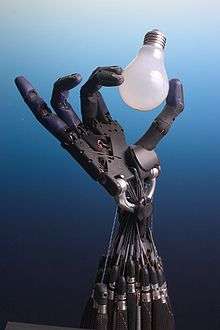OpenROV
OpenROV (open-source remotely operated vehicle) is a low-cost telerobotic submarine/underwater drone built with the goal of making underwater exploration and education affordable.[1][3][7]
 OpenROV submarine from Xeopesca at A Estrada. | |
| Developer | Matteo Borri, David Lang, Eric Stackpole and DIY community[1][2][3] |
|---|---|
| Manufacturer | OpenROV and DIY community[4] |
| Type | Telerobotics submarine underwater drone |
| Release date | circa 2012, current version: 2.8 (26 Jun. 2017) [5] |
| Units sold | 118 (2012)[6] |
| Operating system | Linux[5] |
| System-on-chip used | TI AM335x (BeagleBone Black on-board computer) |
| CPU | 1 GHz (BeagleBone Black ARM Cortex-A8 processor)[5] |
| Memory | 512 MB DDR3 (BeagleBone)[5] |
| Storage | 4 GB eMMC on-board flash storage |
| Camera | HD USB webcam with 4 LED light arrays on servo-tiltable platform[5] |
| Connectivity | 100 Mb ethernet data tether[5] |
| Power | 8 26650 recharchable batteries (~2h run time)[5] |
| Dimensions | 30 cm (12 in) x 20 cm (7.9 in) x 15 cm (5.9 in)[5][6] |
| Mass | 2.6 kg (5.7 lb)[3][5] |
Telerobotic submarine
OpenROV is a remotely operated mini-submarine that weighs ~2.6 kg and has dimensions 15 cm x 20 cm x 30 cm.[5][6] This submarine is powered by 26650 Li-Ion batteries and can be assembled from common materials, with the most expensive piece being the BeagleBone Black Linux computer (~$89). The submarine is controlled from a laptop computer connected to the submarine via a tether and is equipped with on-board LEDs and a camera.[1] OpenROV is an open-source hardware project. By providing the list of the submarine parts and instructions on how to assemble them, the developers aim to democratize underwater exploration.[4]
Community
In addition to being a robotic submarine, OpenROV is also a DIY community of amateur and professional OpenROV submarine builders in over 30 countries that pursue underwater exploration.[4] OpenROV forums provides a platform for users to discuss ideas, solve problems, and share information.[8] Similarly, users can document builds, projects, and deployments on the Open Explorer platform.[9]
Hall City Cave
The development of the OpenROV submarine was in part fueled by the legend that stolen gold is hidden in the deep waters of the Hall City Cave located near Hayfork in Trinity County, Northern California. According to the legend, a few renegade Native Americans stole ~100 pounds of gold nuggets from miners in the 1800s, but were chased. To escape from the pursuit, the renegades had to bury the nuggets in deep waters of the nearby Hall City Cave to lighten their load, but could not retrieve the gold, because they were soon caught and hanged. Even though many have tried to find the gold, nobody has been able to get to the bottom of the narrow and deep well of the cave.[2][10] Some of the OpenROV testing has taken place at that cave.[1][7]
However, there appears to be no newspaper reports of this particular ambush and murders, though there is a report of two miners being murdered and the gold being buried on one of the river flats of the upper Trinity River.[11]
Developers
The idea to build OpenROV was pioneered by Eric Stackpole, an engineering intern at NASA at the time, to discover whether the legend about the hidden treasure of the Hall City Cave was true. David Lang, a self-taught sailor from Minnesota, heard about Stackpole building a small, cheap, and robust submarine in his garage to search for the gold and became inspired to join. Matteo Borri designed and built the electronics, software and motor system for a prototype presented at the World Maker Faire in 2011. Lang and Stackpole co-founded OpenROV as an open-source hardware project, a startup, and a DIY community.[2]
References
- Lam, Brian (May 28, 2012). "A Mini Sub Made From Cheap Parts Could Change Underwater Exploration". The New York Times: Bits. Retrieved May 28, 2012.
- Buhr, Sarah (November 23, 2013). "OpenROV wants to get to bottom of underwater mystery". USA Today: Tech. Retrieved November 24, 2013.
- Lang, David (February 2013). "My underwater robot". TED. Retrieved December 7, 2013.
- "OpenROV website". May 28, 2012. Archived from the original on September 21, 2014. Retrieved May 28, 2012.
- "OpenROV Hardware Overview". OpenROV Wiki. Retrieved December 7, 2013.
- "OpenROV - The Open Source Underwater Robot". Kickstarter. Day funded: July 31, 2012. Retrieved December 7, 2013. Check date values in:
|date=(help) - Branwyn, Gareth (Feb 9, 2012). "OpenROV Testing at Hall City Cave". Make: Robotics. Retrieved May 28, 2012.
- "OpenROV Forums". forum.openrov.com. Retrieved 2015-10-19.
- "OpenExplorer". openexplorer.com. Retrieved 2015-10-19.
- McCracken, Dave. "Talking about putting yourself way out there beyond where you should not be!". The New 49′ers Club: Gold Mining Adventures. Retrieved November 24, 2013.
- Genzoli, Andrew (13 July 1968). "The Hall City Cave Story". The Times Standard. Eureka, California. p. 9. Retrieved 11 May 2019 – via newspapers.com.
External links
- OpenROV website
- Prototype overview
- Eric Stackpole and David Lang explain OpenROV on Kickstarter (2012)
- Eric Stackpole explains OpenROV on YouTube: NASA Space Apps Challenge (2012)
- Eric Stackpole explains OpenROV on YouTube: Aquarius Reef Base (2012)
- David Lang explains OpenROV at TED (2013)
Bibliography
- El Jalaoui, A. (2007). Gestion Contextuelle de Tâches pour le contrôle d'un véhicule sous-marin autonome (Doctoral dissertation, Université Montpellier II-Sciences et Techniques du Languedoc).
